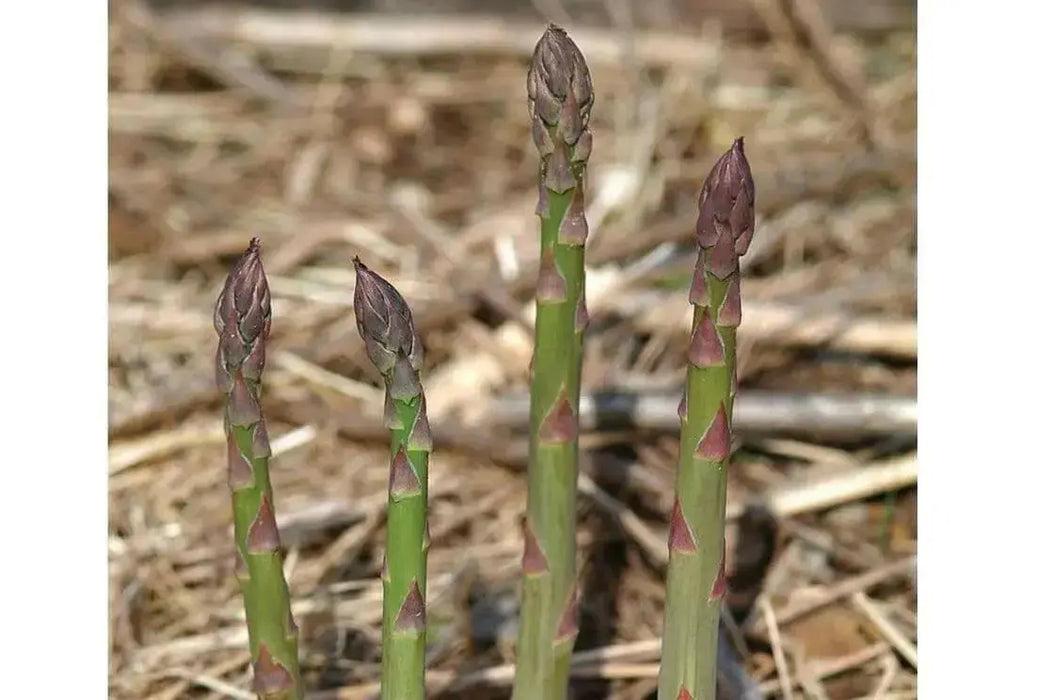
Jersey Giant Asparagus Crown, perennial Garden Vegetable
- Get free shipping to lower 48 states on orders $54.95+ (Most Items), excluding live plants, plant bulbs, and black plastic nursery crate.
- Most orders are processed by the next day
- Select your desired size and/or color from the available options.
We supply hardy, Two-year-old crowns. Perennial.
Asparagus is extremely nutritious and has many health benefits! The ‘Jersey Giant’ variety is an all male hybrid that is highly productive and very vigorous. (NJ56 x JN22-8) Patented. Best for high yield, fine flavor and the largest succulent spears. Resists fusarium wilt, crown rot and rust. Twice the yield of old-fashioned kinds.
This is one of the most popular varieties grown by home gardeners and for commercial planting. This variety is very adaptable and gives excellent yields. It has high disease tolerance. The purple bracted spears are large and a very attractive green. ‘Jersey Giant’ is the most winter hardy of all the Jersey Hybrids and it is widely adapted to temperate and cool climates. It produces medium to large (7-9 inch), green spears with purple bracts. ‘Jersey Giant’ prefers well worked organic soils. Grows well throughout the Midwest.
Asparagus gets top dollar at the supermarket, but commercially grown spears never measure up to the delicately sweet flavor of homegrown. Asparagus is a hardy perennial. Asparagus is a highly productive vegetable. Grown for the stems or spears, a well-tended planting yields 8 to 10 pounds or more per 100 square feet of bed or 24 to 30 pounds per 100 feet of row. For most home gardeners, one row is adequate. An asparagus planting lasts 15 to 25 years without replanting if it is well cared for and the climate is suitable. It does not do well if summers are extremely hot and long and winters are mild.
1 AmenPd your soil the fall before planting asparagus crowns to boost potassium and phosphorus. Apply 20 pounds of 10-20-10 fertilizer or mature compost per 1,000 square feet of soil. Work the fertilizer into the soil at a depth of 6 inches.
2 Select a planting site. Asparagus needs well-drained soil and full sunlight. The crowns thrive in sandy loam soil, but they will grow in other soil types.
3 Dig a trench for asparagus crowns in early spring, after the last frost date has passed for your area. Make trenches 5 inches deep and 6 to 8 inches apart. Planting deeper than 5 inches may result in reduced yields.
4 Add 2 pounds of 0-20-0 superphosphate or 1 pound of 0-46-0 triple superphosphate to the bottom of each 50-foot row. Cover the fertilizer with a 1-inch layer of soil.
5 Soak the asparagus crowns in lukewarm water for several minutes before planting.
6 Place asparagus crowns about 18 inches apart in the trenches with the buds pointing up. Gently loosen the roots and allow them to drape over the sides of the trenches.
7 Fill the trenches with three parts topsoil and one part compost to completely cover the crowns. Do not pack or compact the soil, as this makes it difficult for young asparagus spears to emerge.
8 Water the asparagus crowns thoroughly until the soil feels moist. Watch for spear emergence within a week.
9 Allow the spears to develop fully during the first year; do not harvest them.
10 Remove weeds from the trenches regularly. After spears emerge, spreading a 4- to 8-inch layer of mulch over the trenches will help prevent weed growth.
11 Side-dress the trenches with mulch in the fall, before the first frost date. Refrain from cutting back dead asparagus fern growth at the end of the season. Cut the dead growth back in the early spring, after winter has passed.
12 Harvest spears when the plants are two to three years old. Spears begin emerging at 50 degrees Fahrenheit. Harvest 7- to 9-inch spears by snapping them at the base. Do not cut the spears below the soil.
LET OUR CUSTOMER SPEAK FOR US

![[Seeds] - Caribbeangardenseed](http://caribbeangardenseed.com/cdn/shop/files/gift-card-gift-card-1_1024x1024_dfa857db-9150-4315-a362-7f0bb3fb9c47_60x28.png?v=1722895789)




